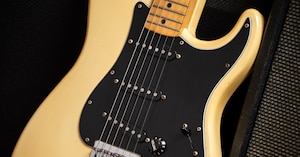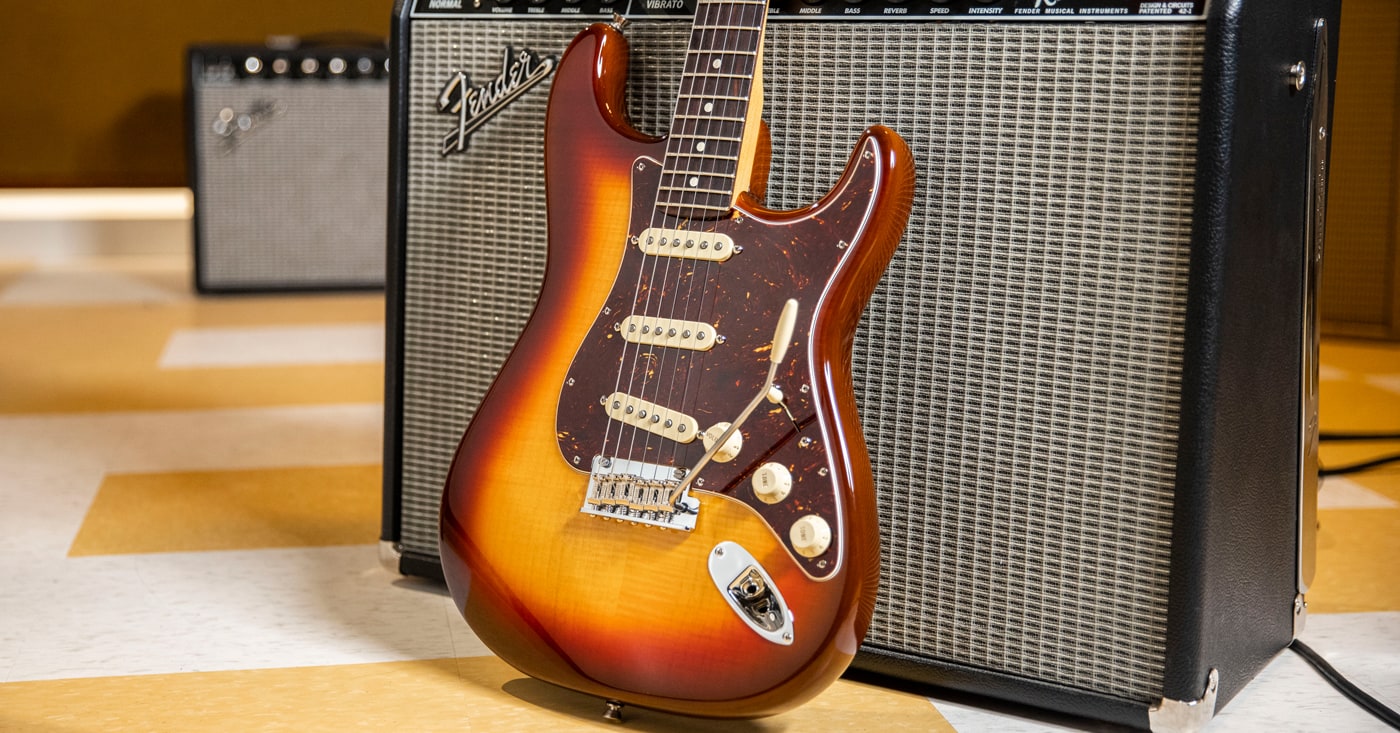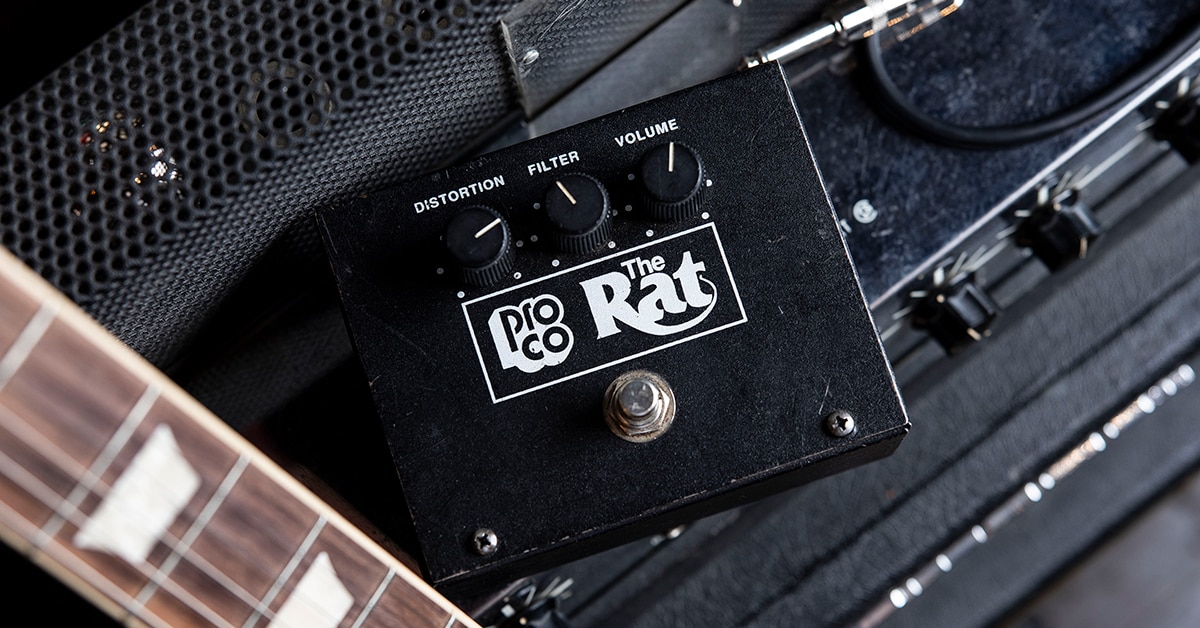Whether from amps pushed to the brink of meltdown or through a plethora of pedals, distortion has been part of the world of the electric guitarist from the very beginning. One of the most popular and enduring pedals guitarists have used to create that warm, fat, grit, howl and growl over the years has been the ProCo RAT. The RAT has gone from modest beginnings to become a worldwide standard against which many other distortion pedals are judged. It has inspired other pedal designers to build tributes and variations of both the original circuit and some of the evolutions that ProCo developed over the years. But just what is it that makes the RAT such an icon?
The Sound of the RAT
The ProCo RAT pedal, in all its various incarnations, stands as one of the most versatile “dirt” boxes around. Use the knobs carefully and you can go from a mildly gritty mid-boost, through a very spongy, tube-like distortion, to a full-blown, hard-clipped fuzz. One of the main reasons for this is the character of the op amp (operational amplifier) chip used in the circuit. Because the slew rate (how fast it can output voltage) of the op amp is relatively low, it adds a spongy, tube-like feel, and this particular circuit runs the op amp at the upper limits of its ability, so the op amp itself starts to clip even before it hits the diodes that provide the hard clipping of heavy distortion and fuzz. Another reason for the RAT’s sound quality is a happy accident resulting from the placement of a mis-read resistor in the original prototype. But that’s the next part of the story.
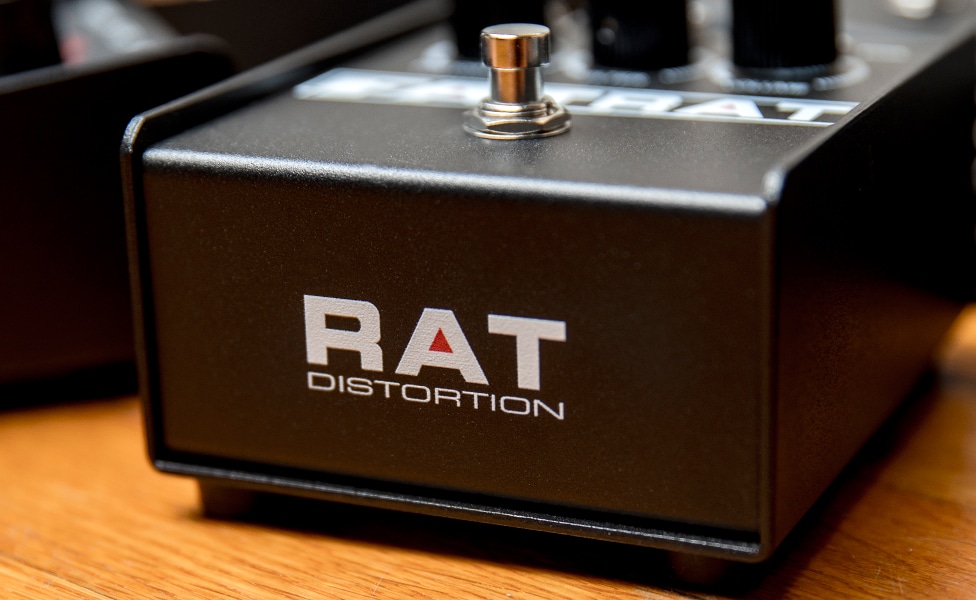
Table of Contents
The Sound of the ProCo RAT
The History of the ProCo RAT
The Evolution of the RAT
Early RAT Pedals
The Turbo RAT
The RAT Op Amp Kerfuffle
Other RAT Variations
Famous RAT Players
Tributes to a RAT
A Guide to the Modern RAT Pedal Models
ProCo RAT2 Distortion Pedal
ProCo Lil' RAT Mini Distortion Pedal
ProCo FATRAT Distortion Pedal
ProCo Deucetone RAT Distortion Pedal
ProCo You Dirty RAT Distortion Pedal
How to Shop for a Vintage RAT
RATS to All of Us
The History of the ProCo RAT
Some products are born out of rigorously applied research and development, spearheaded by a team of MIT or Stanford engineers. Others just sort of happen when someone who loves to tinker sees an existing product and thinks, “You know what? I can do better than that.” The RAT falls into the latter category, thanks largely to the inspiration, drive and imagination of three men—Charlie Wicks, Scott Burnham and “Uncle” Steve Kiraly, all of whom came together at ProCo Sound in Kalamazoo, Michigan. ProCo was born out of the dissolution of The Sound Factory, a building housing a cooperative of multiple music businesses, when Charlie Wicks founded the company the day after The Sound Factory was dissolved. For their first several years, ProCo gained a reputation as a manufacturer of high-quality instrument cables (a few folks here have ProCo cables from the late ‘70s that still work just fine) and pro-sound speaker enclosures.
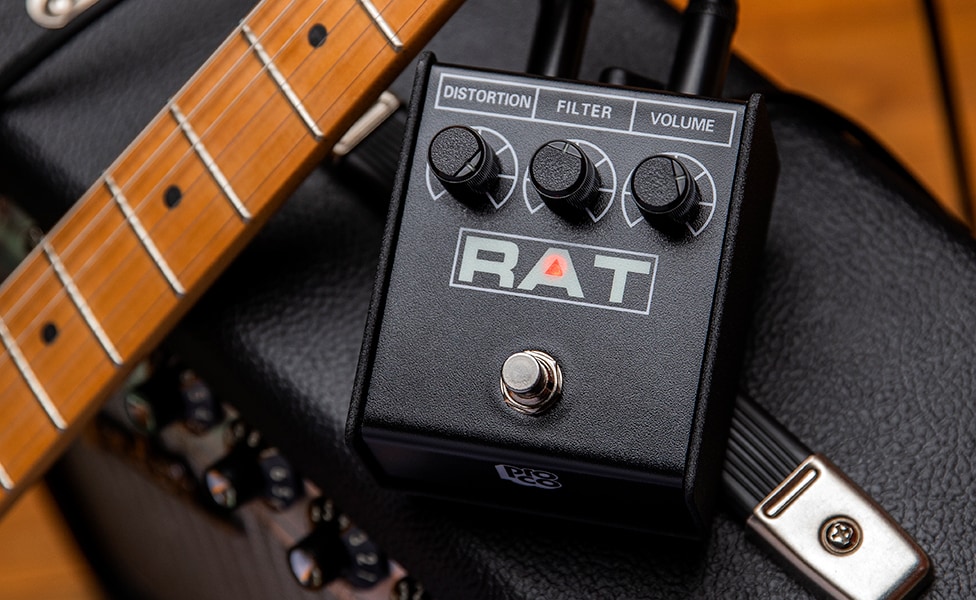
But in the basement of the building, Burnham and Kiraly were modding and repairing amps and pedals. By sometime in the mid-‘70s, Burnham, a guitarist, came to the conclusion that he could build, so to speak, a better mousetrap, and began designing the distortion circuit that would become the RAT pedal. The final circuit came together when Burnham inadvertently soldered a 47k resistor, rather than a 470k resistor into the op amp gain section. This caused the op amp to become overloaded and begin to clip the signal before it could even get to the diodes that were intended to create the hard clipping of distortion. It was a sonic revelation that created a totally new type of distortion. In 1978, Burnham had a dozen circuit boards manufactured and began building pedals as custom orders. It wasn’t until 1979 that the first ProCo RAT distortion pedal, known as the “Fringe Logo RAT” due to its early logo artwork, shipped as a regular production unit.
The Evolution of the RAT
There is a lot of mythology out there about the RAT concerning how it changed over the years. We have to offer a tip of the hat to Josh Scott at JHS Pedals for spending most of a decade tracking down original prototypes and pedals, and picking the brains of everyone he could find who ever worked at ProCo regarding the history and legends surrounding this icon of sonic mayhem. Much of the existing mythology dwells around the perceived differences in sound between what were, in essence, simple cosmetic changes to the package. Despite all the changes in typography, control naming, knob type and case size, the circuit inside the box was virtually unchanged (two minor circuit changes that didn’t affect the sonics) all the way up to the introduction of the Turbo RAT in 1989. But it’s probably time that we took a little closer look at just what was happening, both inside and outside that metal box.
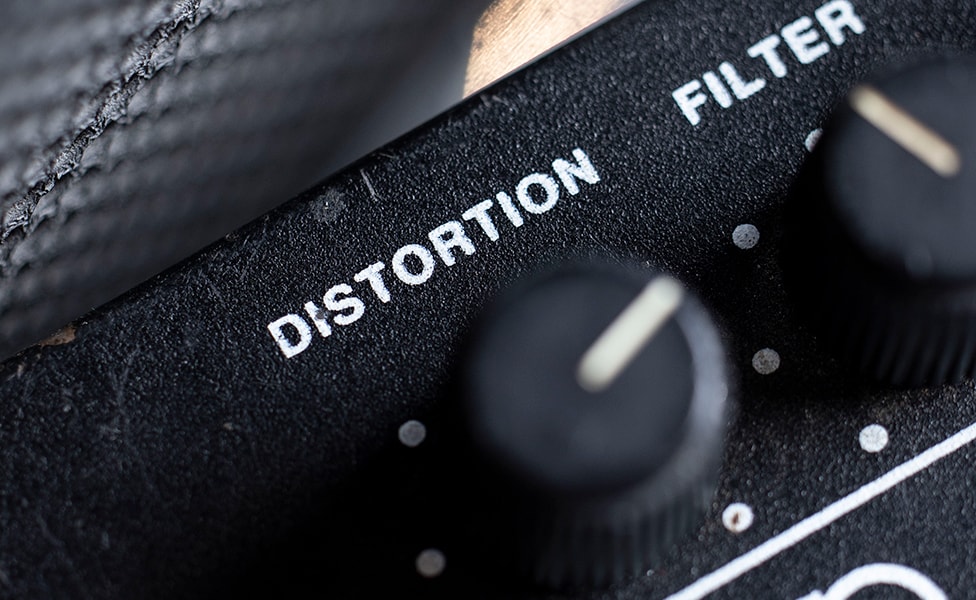
Early RAT Pedals
Once the basic circuit for the RAT had been designed, there were remarkably few changes between 1978 and 1989, which is fairly unusual. Of the two changes, the only one that might be thought to change it sonically was actually more of a user interface change, and did affect player experience with the pedal. This constituted in swapping the wiring on lugs one and three on the pot that was originally labeled “Tone.” This change coincided with the relabeling of that control to “Filter.” What this did was flip the action of the control so that rotating the knob clockwise made the signal darker, rather than brighter. Since flipping those also changed how the taper of the pot affected the change in tone, the sounds that you would have found at a specific knob position before the change would be at a different position after the change. But all the same sounds were still there. Perception, however, is a powerful thing, and the fact that the 12 o’clock position of the Tone/Filter knobs didn’t sound the same as they did before has convinced many people that one or the other of these two versions “sounds better.” The only other change was the addition of an indicator LED, which had no discernible sonic effect at all, that was dubbed the RAT2 (even though the pedal was still labeled simply “RAT”). All of this takes us to 1989 and the introduction of the Turbo RAT.
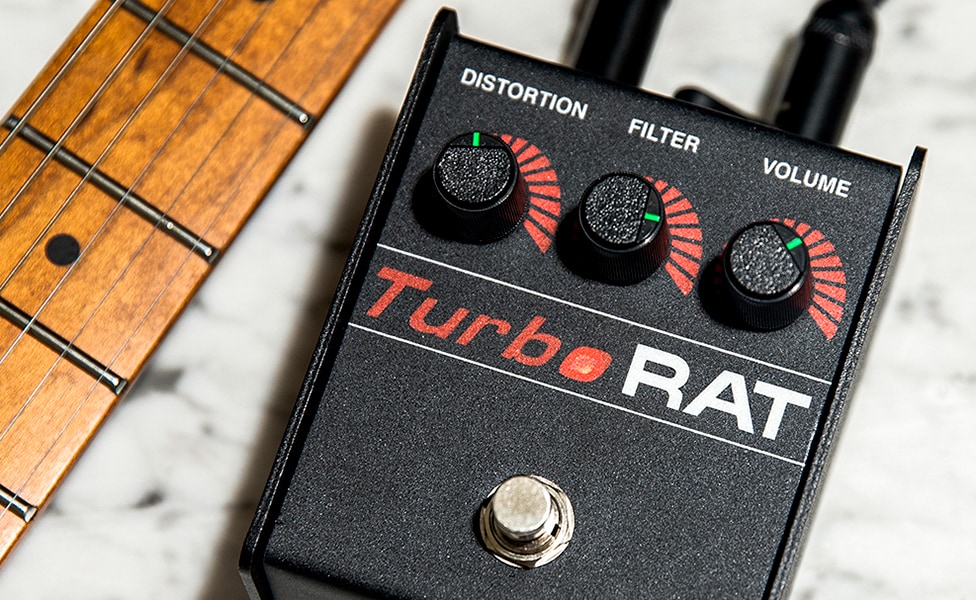
The Turbo RAT
In order to explain the Turbo RAT, we must also introduce Gerry Carpenter, aka “Grape,” another ProCo engineer and guitar player. As someone who routinely played into an already distorted Marshall amp, Grape wasn’t happy with the way the traditional RAT could emphasize the low end in his already distorted tone, and was looking for more headroom and dynamic range, while still being able to go to the full, fuzzed-out glory of the original. His solution, inspired by a Craig Anderton article about using clipping diodes, was to swap out the traditional 1N4148 silicon diodes for a pair of the red LEDs that ProCo had been using for the status indicator light. This elegantly simple change turned the lower end of the pedal’s gain control into a very effective overdrive/boost. Charlie Wicks saw the brilliance of this, and the Turbo RAT become a regular ProCo product, boasting a new, slant-front enclosure that would become standard across the whole RAT family over the next couple of years.
The RAT Op Amp Kerfuffle
Time for a look at another one of the controversies that swirl about the RAT. This one has to do with the switch from the original Texas Instruments LM308 op amp that had been used from the very first circuit design to the OD07DP op amp in 1996. This swap happened because, in a familiar occurrence to anybody who messes about with building their own circuits, TI had discontinued manufacturing the LM308, and a suitable substitute had to be found. The substitution was engineered by the aforementioned Gerry “Grape” Carpenter, who chose the OD07DP because its slew rate and other critical specs were identical to the original part. In fact, if you run a gain/frequency analysis of the two parts, the two plots will overlap as precisely as the tolerances of any two analog op amps will allow. As JHS’ Josh Scott points out in his definitive piece on RAT history (well worth checking out), the tolerances of the other components in the circuit have far more effect on any individual unit’s sound than the op amp does. This is one of the things we’ll touch on in a later section on shopping for vintage RAT pedals.
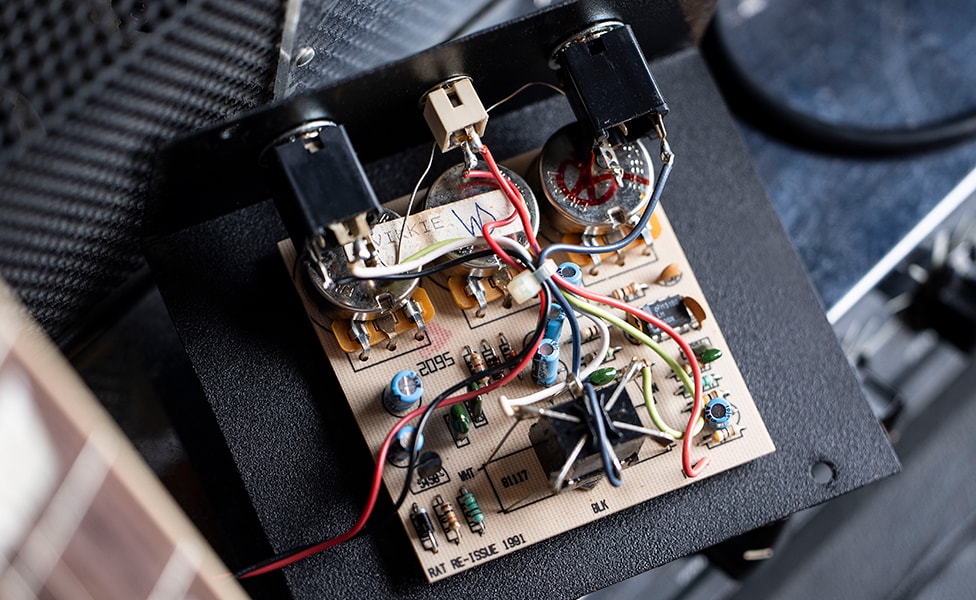
Other RAT Variations
After the Turbo RAT, variations on the original circuit began to pop up with greater regularity, sometimes for competitive reasons, sometimes because somebody at ProCo had a bright idea, and sometimes because there was a request that made sense.
One of those requests is close to home for us. In 1996, ProCo and Guitar Center struck a deal for an exclusive RAT version called the “Roadkill,” which was intended as an entry-level distortion pedal for young guitarists who had been influenced by the grunge scene. Another design from Grape, it was a major variation from the standard RAT, incorporating a buffered input, soft clipping in the op amp stage, some capacitor changes that affected the filter control (here dubbed “Screech”), while maintaining access to the traditional RAT hard clipping sound. As a budget pedal with a partly plastic enclosure to cut costs, it was easily affordable, and was many players’ intro to the world of the RAT. Always frugal and on the outlook for new sales opportunities, Charlie Wicks soon came out with a non-exclusive version of this same pedal, named the “BRAT,” which would be available to other music stores.
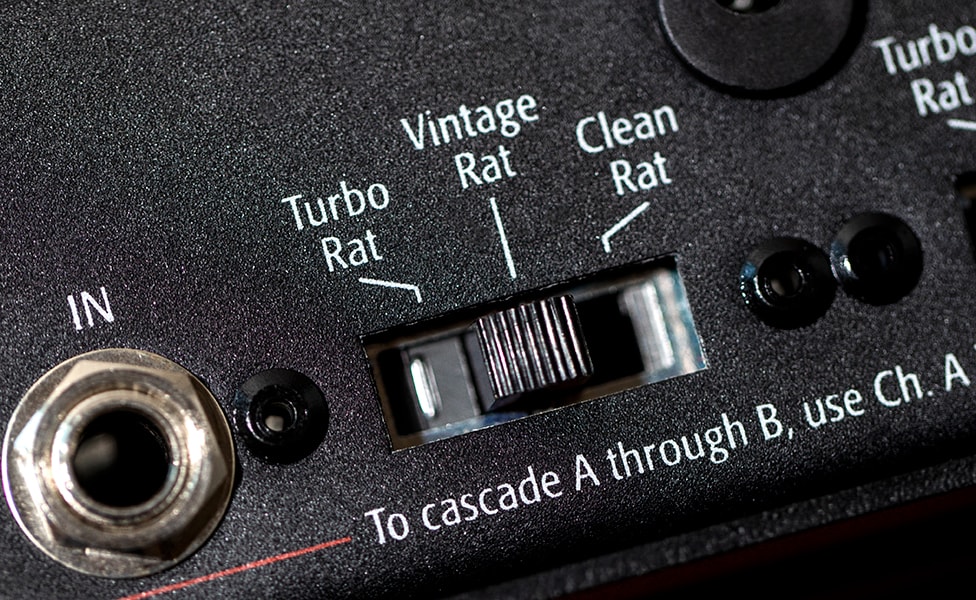
Another Grape concept, the 2002 release of the Deucetone RAT, harkened back to the fate of two of Scott Burnham’s original circuit boards, which had been incorporated into a large, double pedal as a custom order, as well as a short-lived, late-1980s rackmount unit that had been called the R2DU (RAT2 Dual Unit). The Deucetone took that concept of two RATs in one pedal and built on it. The pedal combined the Turbo mode, Vintage (1N4148 diodes), a clean mode and a brand-new mode, which would soon debut in its very own pedal—Dirty RAT mode. This mode replaced the clipping diodes with germanium 1N34A diodes that created a much more saturated, compressed distortion. The dual circuits in the Deucetone could be run independently or stacked, which provided an incredibly wide range of available distortion tones in a single (double) pedal enclosure.
Players loved the new Dirty RAT mode so much that they began requesting a new pedal that contained just that mode. ProCo, always responsive to their customers, was more than happy to comply, resulting in the You Dirty RAT pedal in 2004.
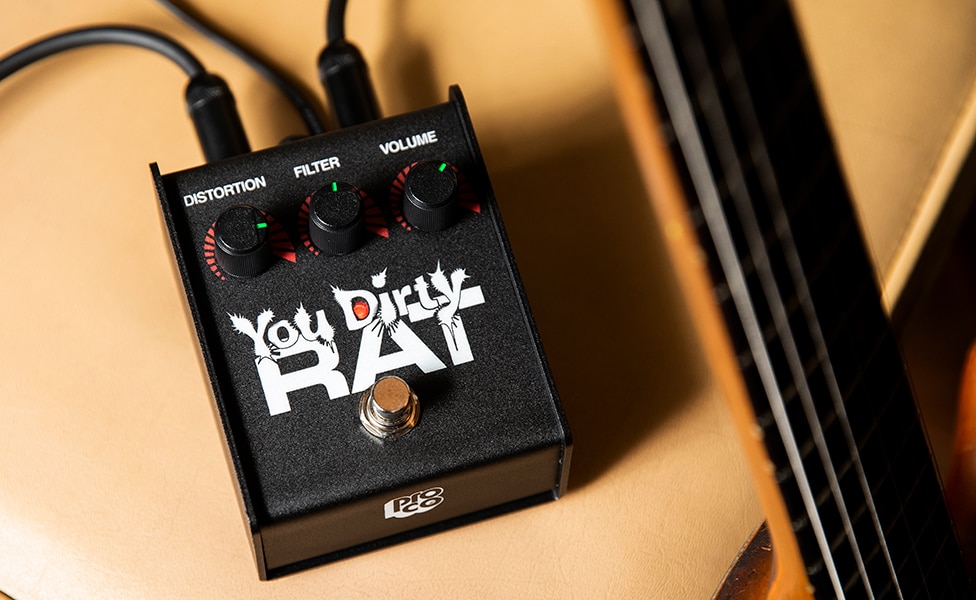
There are two other significant RAT variations to touch on, the SOLO and the FATRAT. The SOLO, like the Roadkill, didn’t have the RAT designation on the pedal—and some consider this to be Grape’s magnum opus—adding several new features and some topology changes to the circuit. These constituted the addition of an asymmetric clipping setting for a more tube-like response, multiple diode configurations and swapping in separate bass and treble controls for the Filter knob.
The FATRAT, debuting in 2014 and still in production today, was a group effort by a team of ProCo engineers capturing many of what had become the most common aftermarket mods to the RAT and adding a couple of new twists. These new features included a bass enhancement circuit, switchable clipping, like the SOLO, but with a new MOSFET section for a fresh flavor. Considered by many to be the most versatile RAT pedal that ProCo produced, it’s a great choice if you can only have a single RAT family pedal.
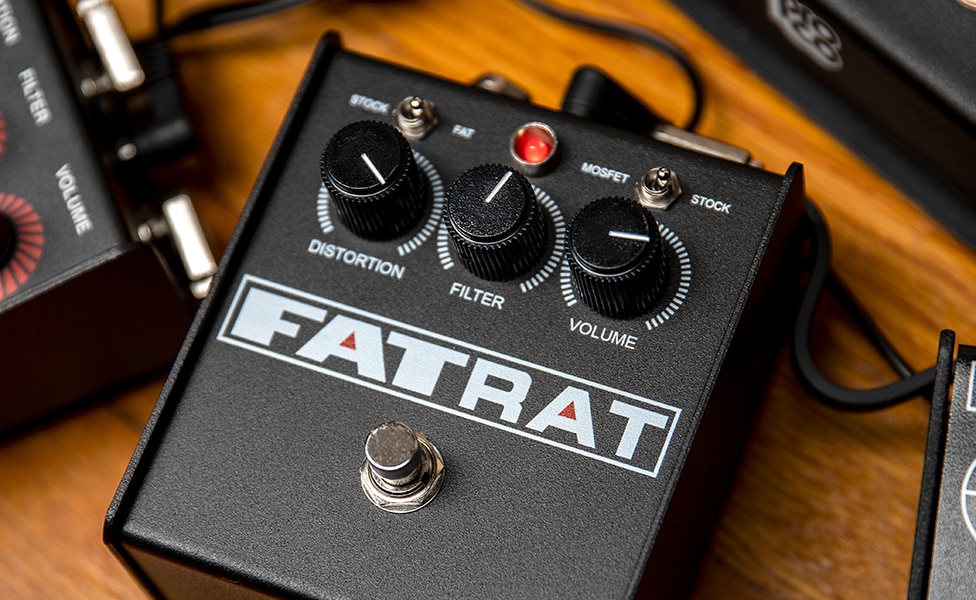
We’ve glossed over several different reissue variations in this abbreviated history, like the 1991 "Big Box" reissue that came through our vintage collection, which we've shown above, largely because they were not separate circuit designs, but just cosmetic packaging for already existing ones. We’ll come back to a few of these in our “Shopping for a Vintage RAT” section.
Famous RAT Players
A comprehensive list of this question would be more easily put as, “Who hasn’t played a RAT?” As one of the most iconic distortion pedals of all time, it has found its way onto more pedalboards than you could stomp on in your lifetime. Here, nonetheless, is a list of some of the more notable RAT users over the decades.
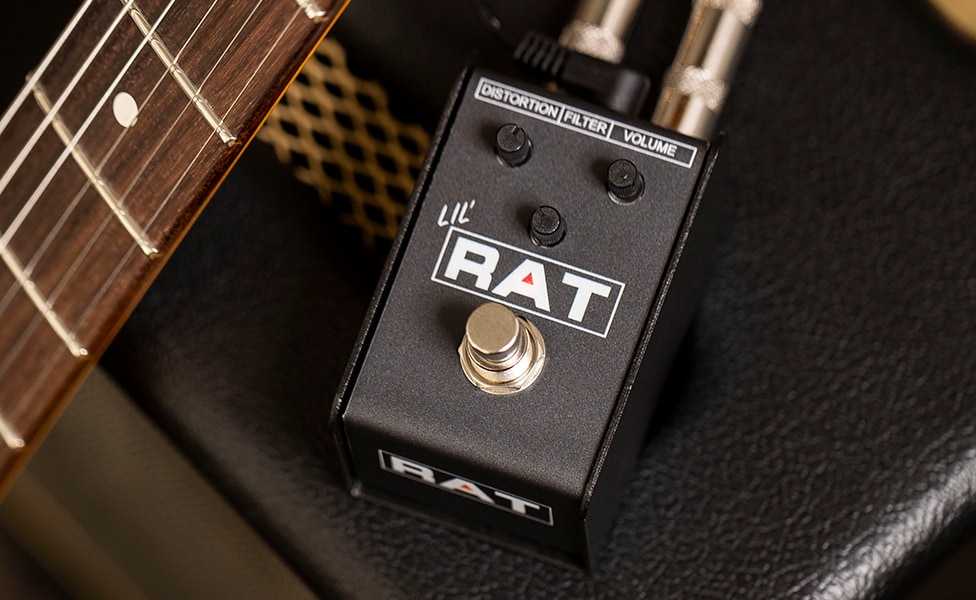
Let’s start with the classic rock world, where we’ll find that David Gilmour, Jeff Beck, Robert Fripp, Joe Perry, Andy Summers and Joe Walsh are all in the RAT pack.
Moving up a few years, Nuno Bettencourt, Jerry Cantrell, Dave Grohl, James Hetfield, Thurston Moore, Thom Yorke, Rivers Cuomo, John Ashton, Frank Black, Kurt Cobain, Krist Novoselic and Graham Coxon have all stomped on a RAT.
RAT pedals have also been the distortion of choice for shoegaze guitarists like Mark Gardener, Neil Halstead and Kevin Shields, along with other contemporary guitarists like Nels Cline, Matt Bellamy, John Christ, Ira Kaplan, Trey Azagthoth and many, many others.
Even among jazz players, like John Scofield, Bill Frisell, Kurt Rosenwinkel, Kevin Eubanks, Sonny Sharrock and Ben Monder, the RAT has found a place on their pedalboards.
That’s just a handful.
Tributes to a RAT
The RAT is one of those pedals that offers a beacon to other pedal designers. From DIY kits to boutique pedal companies, there have been numerous distortion pedals over the years inspired by Scott Burnham, Steve Kiraly and Gerry Carpenter’s circuit designs for the RAT family. Some of these, like the JHS Pack Rat, give you the option to switch between the various iterations of the RAT circuit to find the one that inspires you. Others, like the Walrus Audio Iron Horse, aim directly at the legend of the LM308-based RAT versions, offering the ability to switch between the original and Turbo versions. The ProCo RAT has inspired so many pedal designers and builders, that almost every one worth their salt seems to have created a loving tribute to the adorable little rodent. To name just a few: Brian Wampler’s Ratsbane; the Catalinbread Katzenkonig, which combines a RAT and a Tone Bender MkII in a single pedal; the Electro-Harmonix Flatiron Fuzz, inspired by the RAT2; and the EarthQuaker Devices Sunn Life, bringing a RAT-style distortion together with a tribute to the Shin-Ei octave fuzz pedals. That three of these last four combine sounds, it’s obvious that the RAT loves to play with others. In addition, there have also been countless emulations and digital models, all aiming to use new technology to recreate that classic analog distortion vibe.
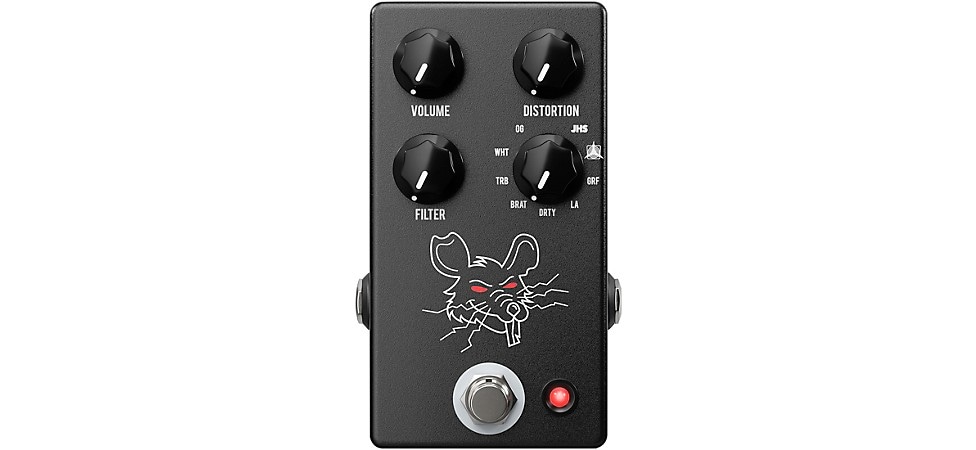
Pictured: JHS Pedals PackRat Distortion/Fuzz Effects Pedal
When all is said and done, ProCo is still around and making multiple different takes of the entire history of their groundbreaking distortion, and starting with the original is always a good choice.
A Guide to the Modern RAT Models
Virtually the entire history of the RAT distortion pedal is currently available from ProCo, so here’s a quick look at five different takes you can stick on your pedalboard today.
ProCo RAT2 Distortion Pedal
Featuring the original circuit from 1981 (well, with the current 07DP op amp, but that really doesn’t make a difference, as we noted above, and the LED indicator), the RAT 2 pedal delivers the distortion you need from grit to full-blown fuzz.
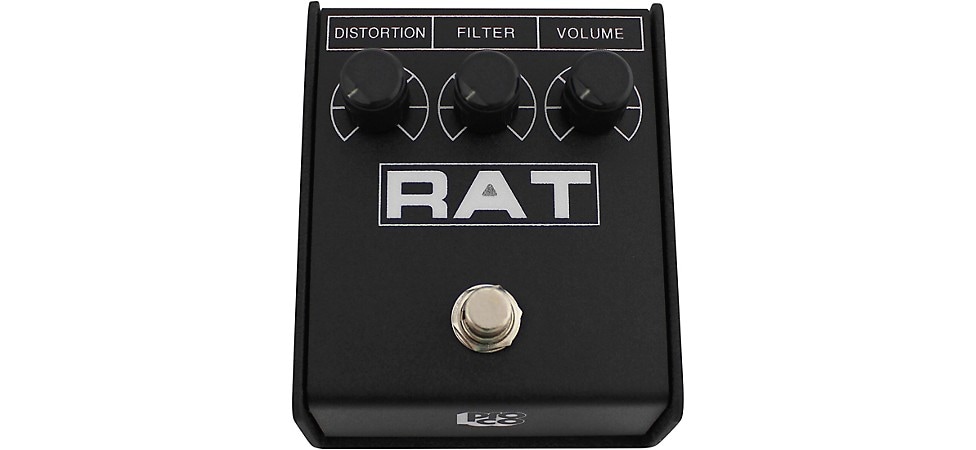
Pictured: ProCo RAT2 Distortion Pedal
ProCo Lil' RAT Mini Distortion Pedal
Running lean? Not a lot of room left on your pedalboard, but you still want that ratty, ratty goodness? The ProCo Lil’ RAT has got you covered. Modern surface-mount components mean you can get huge sound from a tiny pedal. Plus, it’s just as cute as a little baby rat.
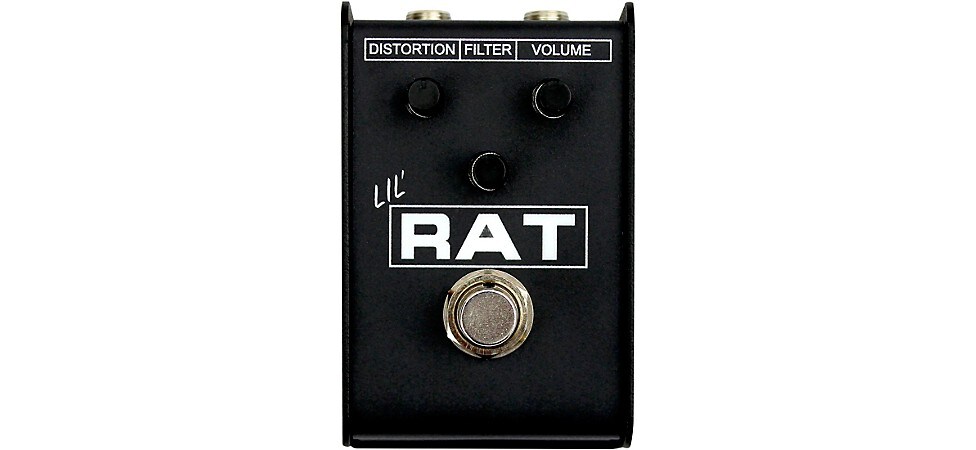
Pictured: Pro Co Lil' RAT Mini Distortion Pedal
ProCo FATRAT Distortion Pedal
As we mentioned above, the FATRAT is lauded as the most versatile ProCo RAT ever, coming standard with all the popular aftermarket mods and the tonal expansion of its MOSFET mode. Highly recommended if you’re just getting your RAT on.
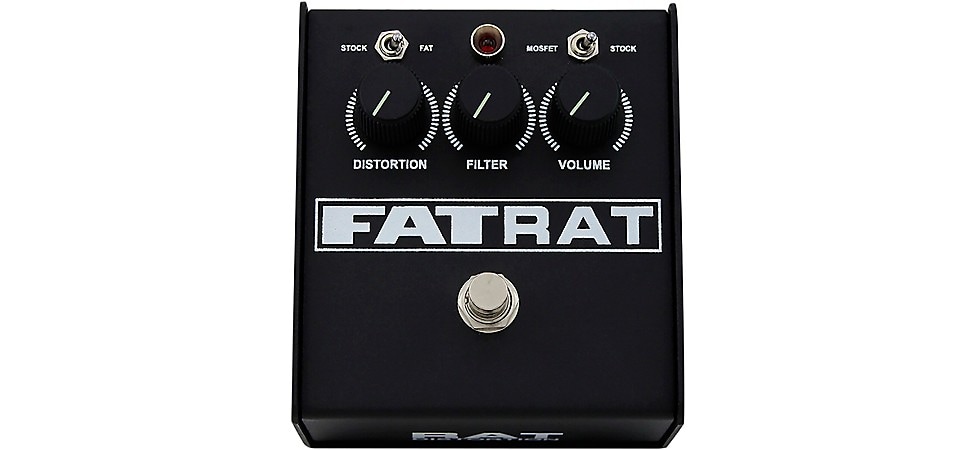
Pictured: ProCo FATRAT Distortion Pedal
ProCo Deucetone RAT Distortion Pedal
The ProCo Deucetone RAT gives you two separate RAT circuits with all three diode variations, selectable by switch. The two circuits can be run sepaRATely for instant access to two different distortion tones, or stacked for some seriously over-the-top distortion sounds.
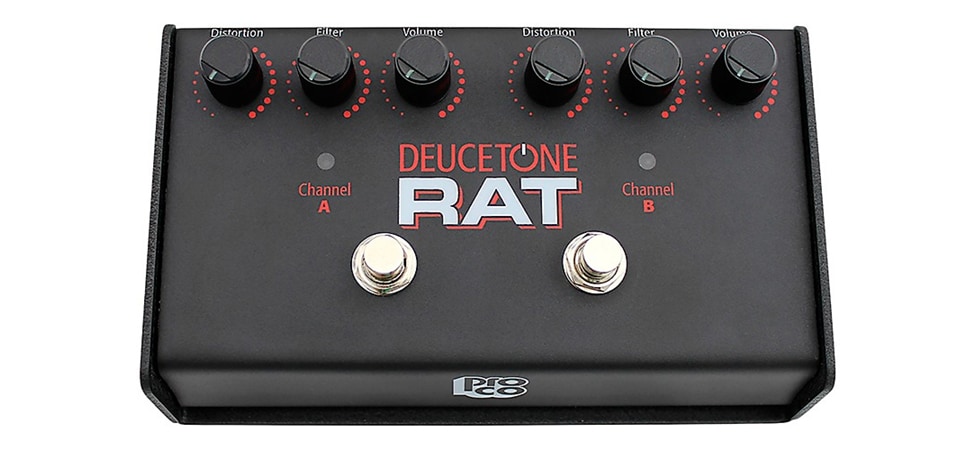
Pictured: ProCo Deucetone RAT Distortion Pedal
ProCo You Dirty RAT Distortion Pedal
Finally, even though James Cagney never actually said the words, ProCo makes sure that You Dirty RAT lives on in all its glory. This RAT version features the funkily unpredictable saturation and compression of the original, though the increasingly hard-to-find germanium diodes have been replaced by Schottky BAT-41 diodes, which offer identical performance but greater thermal stability than the original parts.
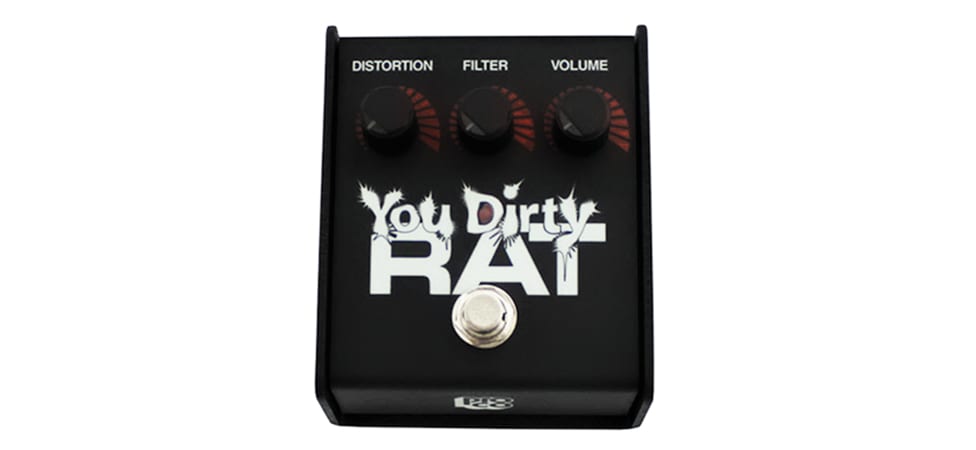
Pictured: ProCo You Dirty RAT Distortion Pedal
How to Shop for a Vintage RAT
Once you’ve fallen under the spell of the ROUS (RATs of Unusual Sound—hey, who doesn’t love a Princess Bride reference), you may be tempted to go out and find a vintage RAT pedal or three. As with every vintage shopping experience, it’s best to start with a little basic education so you know what to look for. That way, you can be sure that what you end up with is what the seller said it was. So, here are a few RAT-specific tips.
First, learn the different packages, paint variations, logo variations and such. The Josh Scott article we’ve mentioned a couple of times is a great place to start with, as it has a comprehensive photo collection that identifies all of those. Know which one goes with which year.
Second, learn the circuit boards. We’re not suggesting that you take up electronics as a hobby (although pedal building is fun, and you meet some really interesting people), but learn enough to identify components and the general look of the different circuit boards. For instance, if someone is selling what they claim is an original circuit RAT, and you open it up and see LEDs instead of regular silicon diodes, it’s either been modded, or it’s a Turbo RAT board put in an earlier box, and you should negotiate accordingly if you’re still interested.
Third, know what it’s supposed to sound like. It’s a good idea to already be familiar with the pedal so that when you plug into a vintage version, you can tell if everything is working the way it’s supposed to.
Fourth, look through the used listings at guitarcenter.com. RAT pedals, even vintage ones, are not super uncommon, and we frequently see them come into our extensive used and vintage collection (but jump quick when you see one, because they never last long). We’ll be glad to help you track down the RAT of your dreams.
RATs to All of Us
After all that, you’ve got a lot to digest. Considering that the RAT has been with us for closing on five decades, that’s to be expected. But even after all that time, it’s still one of the most popular and widely used distortion units out there, and it’s really a must-have for any serious pedal person’s board. We hope this article has put you on the trail, and we’re looking forward to seeing you in your local Guitar Center store, online or through our Contact Center.
Here endeth the tail (sorry—we just couldn’t resist).



